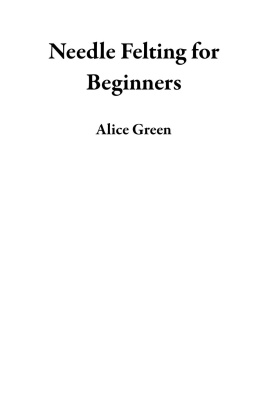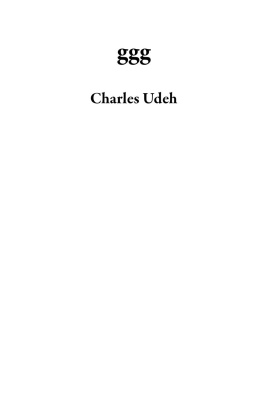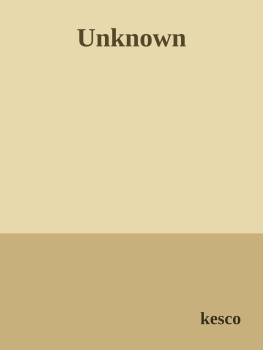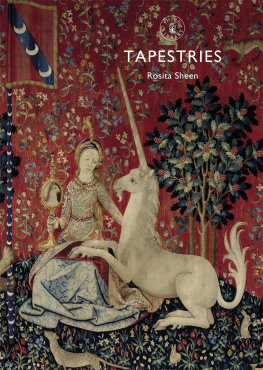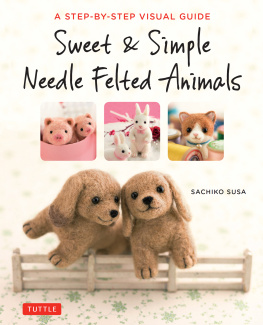Neysa Russo - Needle Felted Tapestries: Make Your Own Woolen Masterpieces
Here you can read online Neysa Russo - Needle Felted Tapestries: Make Your Own Woolen Masterpieces full text of the book (entire story) in english for free. Download pdf and epub, get meaning, cover and reviews about this ebook. year: 2017, publisher: Stackpole Books, genre: Home and family. Description of the work, (preface) as well as reviews are available. Best literature library LitArk.com created for fans of good reading and offers a wide selection of genres:
Romance novel
Science fiction
Adventure
Detective
Science
History
Home and family
Prose
Art
Politics
Computer
Non-fiction
Religion
Business
Children
Humor
Choose a favorite category and find really read worthwhile books. Enjoy immersion in the world of imagination, feel the emotions of the characters or learn something new for yourself, make an fascinating discovery.

- Book:Needle Felted Tapestries: Make Your Own Woolen Masterpieces
- Author:
- Publisher:Stackpole Books
- Genre:
- Year:2017
- Rating:5 / 5
- Favourites:Add to favourites
- Your mark:
- 100
- 1
- 2
- 3
- 4
- 5
Needle Felted Tapestries: Make Your Own Woolen Masterpieces: summary, description and annotation
We offer to read an annotation, description, summary or preface (depends on what the author of the book "Needle Felted Tapestries: Make Your Own Woolen Masterpieces" wrote himself). If you haven't found the necessary information about the book — write in the comments, we will try to find it.
Neysa Russo: author's other books
Who wrote Needle Felted Tapestries: Make Your Own Woolen Masterpieces? Find out the surname, the name of the author of the book and a list of all author's works by series.
Needle Felted Tapestries: Make Your Own Woolen Masterpieces — read online for free the complete book (whole text) full work
Below is the text of the book, divided by pages. System saving the place of the last page read, allows you to conveniently read the book "Needle Felted Tapestries: Make Your Own Woolen Masterpieces" online for free, without having to search again every time where you left off. Put a bookmark, and you can go to the page where you finished reading at any time.
Font size:
Interval:
Bookmark:

Wet Felting Technique
Spark, Patricia. Fundamentals of Feltmaking. Washington: Shuttle Craft Books, 1989.
Claessen, Marlie. Felting. Lochem, Holland: Louet b.v., 1981.
Textile Inspiration
Johnstone, Pauline. Greek Island Embroidery. London: Alec Tiranti Ltd., 1961.
Volbach, W. Fritz. Early Decorative Textiles. Middlesex, England: Hamlyn Publishing Group, 1969.
Fassett, Kaffe. Glorious Inspiration for Needle-point & Knitting. New York: Sterling Publishing, 1991
Liebetrau, Preben. Oriental Rugs in Color. New York: Macmillan Publishing Co., Inc., 1963.
Bath, Virginia C. Embroidery Masterworks. Chicago: Henry Regnery Company, 1972.
Design & Motif Inspiration
McCallum, Graham L. 4000 Animal, Bird &Fish Motifs. London: Batsford, 2005.
Bossert, Helmuth T. Treasury of Historic Folk Ornament. Mineola, New York: Dover Publications, Inc., 1996.
Grafton, Carol B., ed. 400 Floral Motifs for Designers, Needleworkers and Craftspeople. Mineola, New York: Dover Publications, Inc., 1986.
Harrell, Betsy. Anatolian Knitting Designs. Istanbul, Turkey: Redhouse Press, 1981.
Eiland III, Murray. Starting to Collect Antique Oriental Rugs. Suffolk, England: Antique Collectors Club Ltd., 2003.
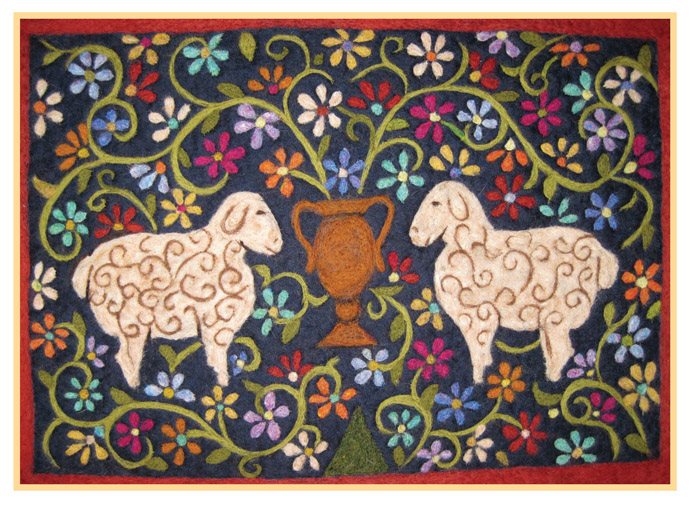
Pre-felt is the starting point for tapestry needle felting; it is used as the base for the projects in this book, and will be your blank canvas. Pre-felt is wool that has been only partially felted and is therefore less dense. It may be manufactured or handmade.
Machine-made pre-felt is a lightly needled, loose fabric. It is usually a very fine, delicate sheet of wool and should be handled gently. It increases in density and durability when exposed to agitation through wet felting. Manufactured pre-felt is available in a wide range of colors, and since felt is a nonwoven fabric, it may be cut to any size or shape without unraveling. Be certain that the pre-felt you purchase is 100% wool. Because it is such a delicate fabric, I often recommend two layers for the projects in this book.
Handmade pre-felt is partially felted wool which has not been fully agitated and will also work beautifully as your blank canvas. The Maple Leaf Coaster project in this book teaches you how to make your own pre-felt from carded wool.

Felting needles come in many gauges with variations related to the configuration, quantity, and depth of the barbs. The work of the needle is done on the bottom inch. As you poke the wool down with the needle, the barbs grasp strands of fiber, pushing them through the pre-felt base and securing them in the needling board underneath.
The best way to get familiar with the variety of needles that exists is by trying them. Besides the arrangement and depth of the barbs, other performance factors include the thickness of your pre-felt, the type of wool that you are using, and whether you are creating flat or three dimensional needle felt.
The 38 gauge needle with a triangular configuration is a great general purpose needle and is used to create most of the projects in this book. A needle with a star configuration is used for both of the three dimensional projects in the book. These needles have more barbs; therefore they push more fiber and work quickly and efficiently when shaping a form.

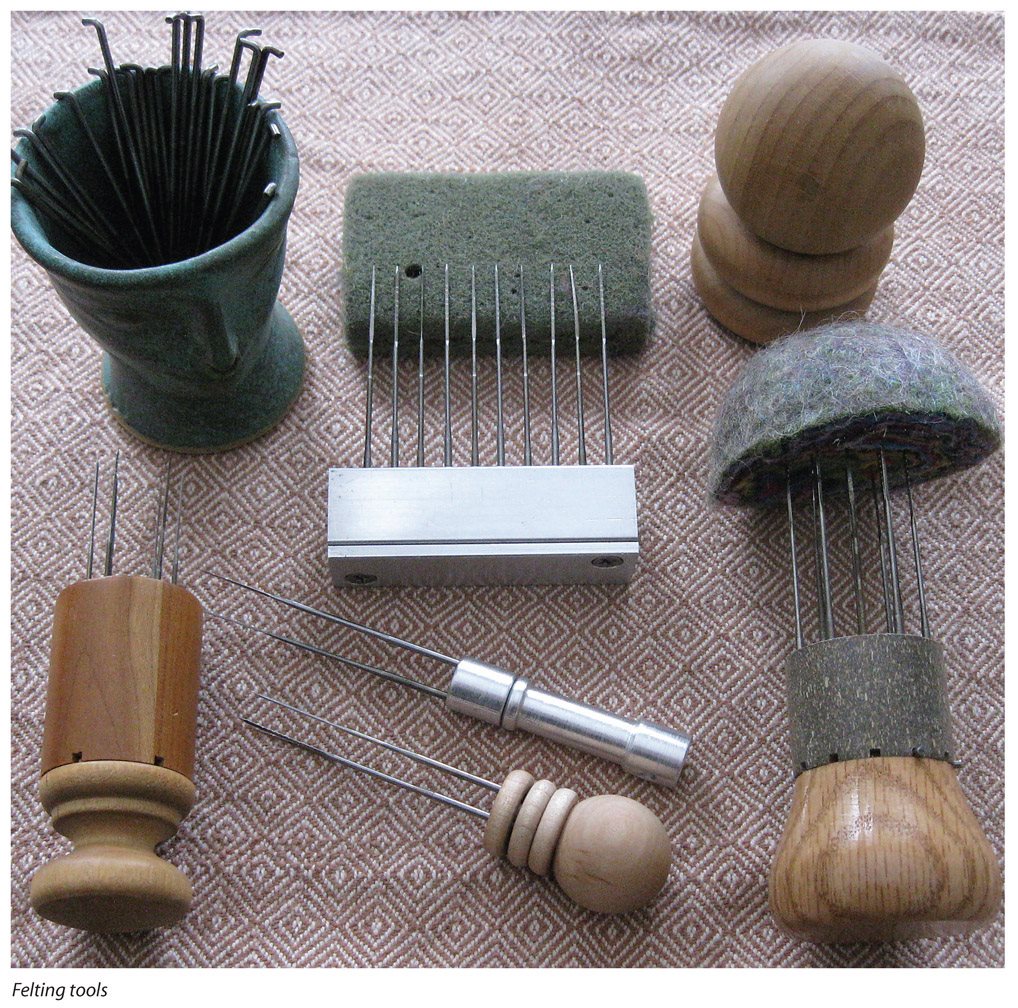
How to Use Felting Needles
To use a felting needle, pinch it between your thumb and finger and poke straight up and down through the pre-felt, landing well into the needling board. You may adjust the placement of fiber by poking at an angle, but you must pull the needle out of the needling board at the same angle it was inserted or it may break.
You will know you have the wrong needle for the job when:
The needle struggles to penetrate the wool, requiring more effort on your part.
The needle glides too easily through the wool, not catching enough strands. This causes you to do more of the repetitive poking motion with less result.
Felting needles are made of carbon steel and are brittle; therefore they will break if mis-handled. Be certain to disinfect any wounds, and remember to secure your needles safely when you leave the work area.
Needling is a repetitive motion that could cause stress to your hand. There are several ways to minimize this.
Be sure the needling board is only an inch thick.
Support your arm and elbow by resting them on the table during needling.
Let go of the needles each time you add more color.
Stretch your fingers and move your hands often.
Use the correct needle gauge for the job.
The more the wool is needled, the better the finished product will look. Needling strengthens the structure of the pre-felt by adding density. It also secures the fibers in place and prepares the design for wet felting. The more needling you have done to your design, the less likely it is that the fibers will float or shift during wet felting.
Check to see if you have needled enough by:
Running your hand over the surface to check for shifting fibers; if you see any movement, needle that area more.
Turning your design over. Felting needles push some of the fiber through, and your design should be clearly distinguishable on the back. If you see a weak area, turn it back over and needle that spot some more, adding more fiber where needed.
Holding the pre-felt up to the light to reveal any weak areas.
You must have a needling board under your project as you work so that the needle has a place to land safely as it penetrates the wool and pushes the fiber through the felt. Since the barbs are located on the bottom inch of the needle, the needling board should be 1 inch thick.
The needling board I used in these projects is blue board foam insulation used in housing construction. I often use that as my needling board because:
It is inexpensive and readily available at the local lumberyard.
It provides a firm, solid backgroundother needling boards may force your wrist and hand to bounce.
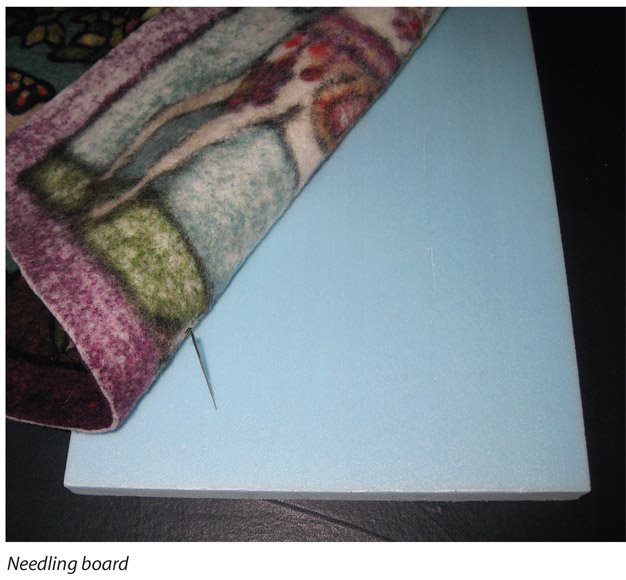
It is available in the ideal 1-inch thickness that I like. If your needling board is less than 1 inch thick, the needle may not be able to push the fiber far enough through and may break if it hits the work table underneath. Needling boards that are thicker than 1 inch may force your wrist upward, creating an awkward and uncomfortable needling position for your hand.
It may be cut to any size.
Foam needling boards sold by felting retailers may be adequate for smaller projects, but as the size of the project increases, you will need a larger needling board, and insulation board is a good option.
Font size:
Interval:
Bookmark:
Similar books «Needle Felted Tapestries: Make Your Own Woolen Masterpieces»
Look at similar books to Needle Felted Tapestries: Make Your Own Woolen Masterpieces. We have selected literature similar in name and meaning in the hope of providing readers with more options to find new, interesting, not yet read works.
Discussion, reviews of the book Needle Felted Tapestries: Make Your Own Woolen Masterpieces and just readers' own opinions. Leave your comments, write what you think about the work, its meaning or the main characters. Specify what exactly you liked and what you didn't like, and why you think so.

